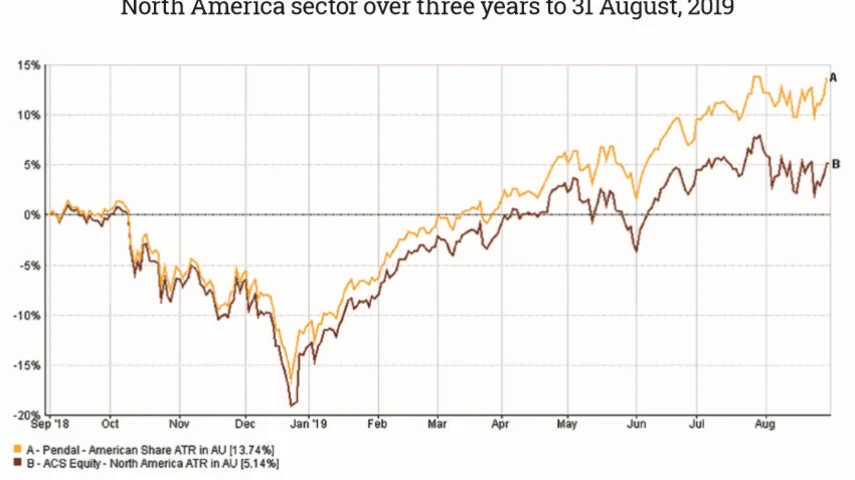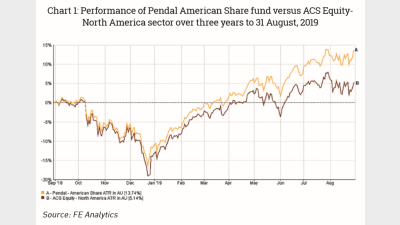Fact Check: Pendal American Share



Amid all the chaos of the US/ China trade war and the questionable actions of US President Donald Trump, one US actively-managed fund is still achieving annual doubledigit returns.
The fund aims to provide a return that exceeds the S&P 500 over the medium to long-term. The firm said its bottom-up fundamental analysis allowed it to identify high-quality businesses with above average sustainable earnings growth.
The target investor, according to the firm’s Product Disclosure Statement (PDS) was someone who wanted long-term capital growth, diversification across a range of North American companies and industries and who was prepared to accept a ‘high variability of returns’, as the risk level was ‘very high’.
One of only four active funds in the ACS Equity-North America sector, the Pendal American Share fund has returned 13.7% over one year to 31 August, 2019, according to FE Analytics, compared to returns of 5.1% by the ACS Equity North America sector.
This followed double-digit returns of 23% in the previous year. Over the one-year period, the only fund that performed better was the VanEck Vectors Morningstar Wide Moat ETF which returned 13.8%. Founded in 1999, formerly as the BT Wholesale American Share Fund, the $37 million fund has been running for more than a decade longer than its rivals and returned 208% over the period. Since 2006, it has been managed by MFS, an alliance formed with Pendal to manage its core international shares.
Despite the ‘very high’ risk label in its PDS, only one out of the last 10 years have seen negative returns. However, they have indeed been variable with annual returns ranging from 51% in 2013 to losses of 1% in 2011.
Looking at its portfolio construction, the fund has 21% invested in technology which is unsurprising for a US fund as technology firms such as Alphabet, Netflix and Apple are large megacap constituents of the US stockmarket. This was followed by 14.5% in healthcare and 13% in consumer discretionary stocks, according to its factsheet.
It may also use derivatives within its asset allocation as a way to reduce risk and act as a hedge against adverse movements in a particular market or underlying asset.
PERFORMANCE CONTRIBUTORS
Looking at the fund’s most recent performance update as of 30 June, 2019, the manager said the fund’s preference for high quality companies had been a tailwind for the fund as the market was favouring these type of asset over cyclical ones which had underperformed over the period.
“If you look at the market performance over the last 18 months, which coincides with the global economy deteriorating, the S&P 500 is essentially flat, with several corrections and recoveries mixed in. Over this period, bond proxies, growth and defensive sectors have outperformed while cyclical sectors have underperformed. This has likely provided a tailwind to our relative performance, as we favour higher quality companies that often have attributes that are more stable.”
Nevertheless, the bulk of performance contributor came from individual security selection and those which had been avoided rather than a broader quality versus cyclical argument.
Strong contributors came from healthcare, industrials and information technology, all large sector weightings for the fund. It also benefited from avoiding semiconductor company Intel, which lowered its guidance, and resources company Exxon Mobil.
However, management said the fund was hindered by not owning bank JP Morgan Chase and entertainment company Walt Disney which beat its earnings expectations thanks to strong demand for its theme parks. It was also hurt by holding oil firm BP which saw its share price fall after weaker prices and refining margins.
In the future, the management team said it would remain focused on stock selection and seek out opportunities to drive long-term performance. These included those companies with healthy balance sheets, pricing power, higher return on equity and less volatile earnings.
However, they admitted they are worried about margins which could be less favourable going forward.
“Margins are at risk due to a cost structure that is rising faster than revenues. Sales growth remains below average, and pricing power is fading due to technology. We are starting to see some signs of this as the number of companies with increasing gross margins is declining,” the team said.
“As a result, when looking at or owning companies that have benefitted from margin improvement, we are now taking a closer look at the key drivers of margin improvement and trying to determine how sustainable it is going forward.”
Recommended for you
Marking off its first year of operation, Perth-based advice firm Leeuwin Wealth is now looking to strengthen its position in the WA market, targeting organic growth and a strong regional presence.
In the latest edition of Ahead of the Curve in partnership with MFS Investment Management, senior managing director Benoit Anne explores the benefits of adding global bonds to a portfolio.
While M&A has ramped up nationwide, three advice heads have explored Western Australia’s emergence as a region of interest among medium-sized firms vying for growth opportunities in an increasingly competitive market.
Private wealth firm Escala Partners is seeking to become a leading player in the Australian advice landscape, helped by backing from US player Focus Financial.











